Sustainable Futures Campers Experience Sustainability In and Out of the Classroom
June 23, 2016
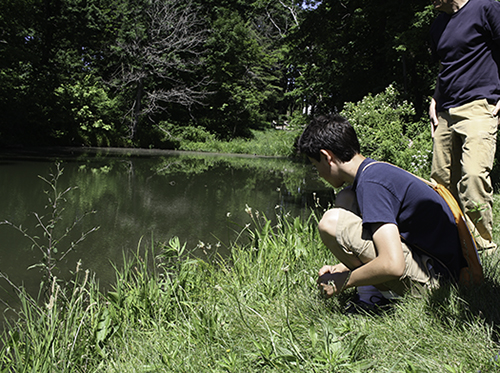
Sustainable Futures camper Jack Easley examines the flora and fauna during a visit to Allerton Park. (Photo courtesy of Jeremie Smith, CGS Outreach Coordinator.)
In its third year, the six-day 2016 Sustainable Futures camp from June 5th–10th, exposed ten high school students to sustainability, both in the classroom and in the real world via tours of local sustainability efforts. One key activity was students’ final group projects, 21st Century Scenarios, which they presented on Friday to camp leaders and several parents. What drew the students to the camp? In addition to learning more about sustainability, several acknowledged that they hoped to discover if a career related to it might be right for them.

Sustainable Futures participants Giulia Barbieri, Jack Easley, Mihir Thakar, and James Brady appreciate their tour of the Woody Perennial Polyculture Project.
Sponsored by the Center for Global Studies and organized by CGS’ Outreach Coordinator, Jeremie Smith, the camp is designed for high school students on the cusp of deciding about college and careers: seven of this year’s campers were rising seniors; the other three were juniors. While a number of the participants hailed from Champaign-Urbana, others came from Illinois and beyond—California, New York, Arizona, and Texas.
The camp’s two main instructors were Jonathan Tomkin, Associate Director of the School of Earth, Society and Environment (ESE) and ESE lecturer Rob Kanter. Both found the camp extremely rewarding.
Tomkin, who taught most of the classroom instruction, says, “It’s a great opportunity to talk about some really interesting ideas with some really interested high school students.” Some of the big trends he addressed? Population, food, water, energy, and climate change.
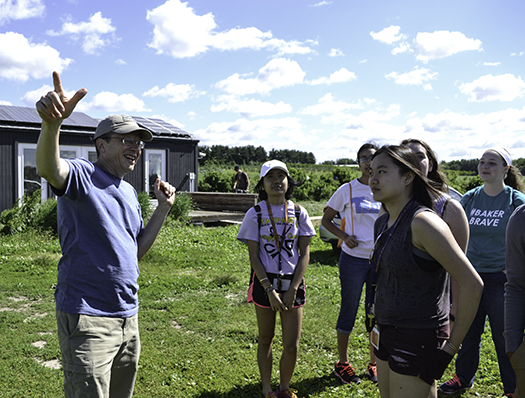
Rob Kanter directs students to some birds during the tour of the Woody Perennial Polyculture Project.
Kanter’s role was to teach the students while on field trips to local places implementing sustainability. For example, at the Student Sustainability Farm and the Woody Perennial Polyculture Project, students heard about sustainable farming, including an alternative to growing just corn and soybeans: a polyculture comprised of chestnut, hazelnut, or apple trees, under-planted with raspberries and currants, and with swaths of pasture between the rows where animals could graze. During a trip to Allerton Park, students heard about environmentally-friendly policies regarding rainwater usage and solar panels being put in place. Back on campus, students toured the new ECE Building, which is aspiring to a Net Zero Energy rating, and learned about water run-off during a visit to Boneyard Creek:
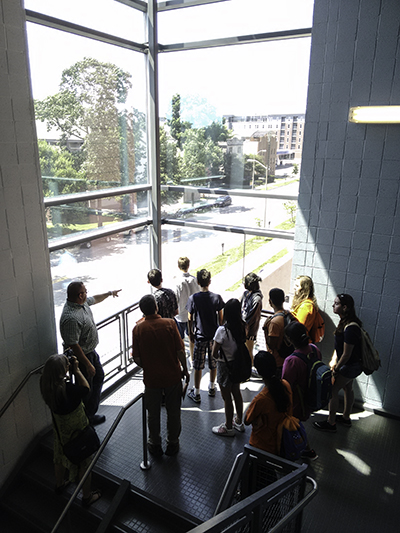
During a tour of the ECE's new building, the campers learn of all of the steps taken during construction to give the building a Net Zero Energy rating. (Photo courtesy of Jeremie Smith, CGS Outreach Coordinator.)
“Jonathan and I complement each other very well,” Kanter explains. “Because I enjoy taking students into the field to see people doing things that have to do with sustainability—hands on, you know, in practice. So that’s what I enjoy doing.”
In fact, Kanter enjoys the camp so much, that he says he would probably do it even if he weren’t paid for it (for which he inserts a caveat not to tell those responsible for his paycheck.)
“This is a fantastic opportunity for me. This is doing something that I enjoy, (don’t tell ‘em) that I would do for free. I mean, to be around young people, high school students who are as interested and as engaged as the students here are, is just a really great opportunity for me.”
Students also learned about the campus, such as university resources, like the library; an evening scavenger hunt, a fun way to expose students to the campus; a dinner meeting with advisors from a number of units. The camp wasn’t all work and no play; fun evening activities included a movie night, bowing at the Illini Union, and a movie on the Quad the last night of the camp.
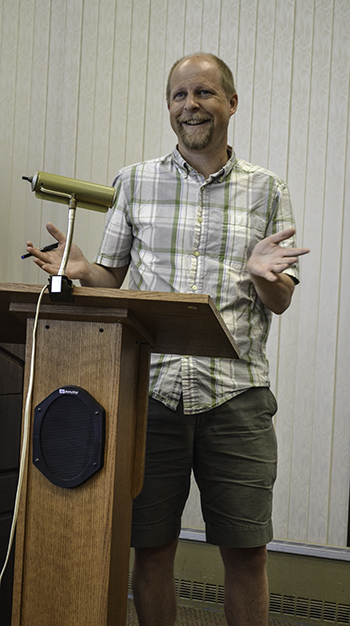
Jonathan Tomkin making introductory remarks at Friday's 21st Century Scenario Project Presentations.
How’d the students do? “They did fantastic,” Tomkin reports. “Very engaged. Very clever. I’m very much looking forward to seeing their final projects.”
Does Tomkin see any of the students going into a sustainability field? “I think it’s very possible,” he says. However, Tomkin sees sustainability as an area that may be addressed via a broad range of disciplines:
“I think my field is very broad,” he explains, “so I’m interested in things pertaining to sustainability and that touches on everything from engineering to business to social science to natural science, and I think I consider it important not just that someone becomes a professional in the field, but also that they use sustainability thinking in other parts of their practice. I’m in the School of Earth, Society, and Environment, and my specialty is actually in glaciers.”
Does Kanter see any of the students going into a sustainability field? “We have to wait a little bit to see,” he says. “What I hope that they learned is that sustainability isn’t something that’s going to happen in the future, but sustainability is something that people are putting into practice now. And that creative, engaged people can change the world now—not sometime in the future.”
Like Tomkin, Kanter also sees sustainability as broader than any one particular field, and hopes that no matter what field the students go into, they try to keep it in mind: “What I really like about this program is that I want all of them to think about what they do in terms of sustainability,” he says. “So they may or may not do work that is called sustainability, but whether they are facilities managers or engineers or urban planners, sustainability can be a part of what they do.”
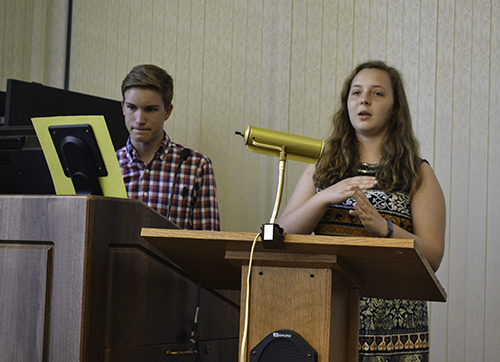
Left to right: James Grady and Anna Balla discuss their 21st Century Scenario final project during Friday's presentation event.
Most of the students participated in the camp in order to discover if a career in sustainability might be in their future. For example, Anna Balla, a rising senior this fall at Mundelein High in Mundelein, Illinois, explains, “I came to camp because I don’t know what I want to study in college, but I am really interested in sustainability and the environment. And so I’m thinking that’s a possible route for me. So I came here to learn more about it and see if that’s what I want to pursue.”

Stacey Chui, a rising senior at Stony Brooks High School in New York.
And according to Balla, she believes she does want to pursue it. “I’ve learned a different way to approach it, you know, than what I thought I was going to do.”
Balla’s favorite thing about the program? The people: “The professors that are so passionate about what they’re doing…you can just see it while we’re out and looking at animals. They just light up, that’s like they’re favorite thing. So that’s what I thought was really unique and cool about the program.
Like Balla, Stacey Chui, a senior this fall at Stony Brooks School in New York, also hoped to discover if she might like a career in sustainability. “I came to camp because I want to know what I want to do or study in college,” she admits, “and this has always been an interesting topic to me and I really want to get to know it more. So think it’s a really good opportunity. It’s not too long. Six days, yeah.
While Chui is still not sure about what career she’s going for, she believes she learned a lot during the camp. “I think it is good. I’ve learned a lot more. Like I’ve learned things that I didn’t really put much thought into it before. And, yea, these are like real-life problems and stuff…It definitely gets me to think more about it. I still don’t really know what I want to do in life, but it gives me some thoughts. Definitely.”
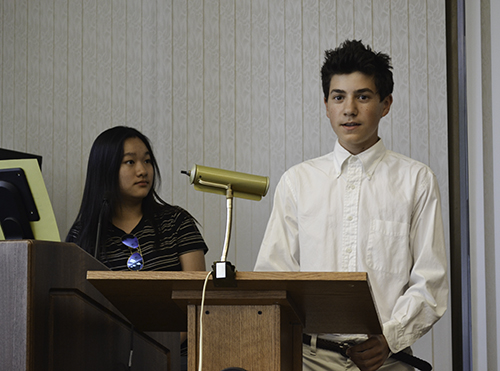
Left to right: Stacey Chui and Jack Easley present their 21st Century Scenario final project during the camp's final event.
Jack Easley, a rising junior this fall at Uni High in Urbana, attended the camp not only to determine if a career in sustainability is for him, but also to live more responsibly himself: “I came here because I knew some surface level stuff about sustainability, but not much,” he admits, “and I think it was something I was definitely interested in finding more about and sort of whether I want to go that direction for a career or college. And just learn more about it, and how I can live more sustainably.”
Easley says he learned a lot, and he thinks participating in the camp is going to change how he lives from day to day, as well as his attitudes about sustainability: “Like just learning about how stuff works…I think it will sort of change more than what I do—sort of how I think about stuff. I think that’s a pretty important thing to do.”

Left to right: Nghi Nguyeni and Sruti Ekkirala enjoy organic strawberries during a tour of the Student Sustainability Plot.
Easley believes he’ll end up in a career in sustainability, something to do with sustainable agriculture. “Systems that can still be efficient,” he explains, and then, also biodiversity, sort of looking at animal species and how we can maintain the biodiversity in areas.”
Another local student, Sruti Ekkirala, who also attends Uni High and will be a senior this fall, was excited about the global aspect of the camp: “I was really interested in the environment and sustainability, and I thought this was a really good opportunity to get the local and global context for that. So that’s why I’m here.”
Ekkirala says she learned a lot more about the big picture: “Joel said something on the lines of how you don’t realize how much energy goes into meat production. I always thought it helps to do your part to turn off the tap and lights when you’re not using them, but in the grand scheme of things those don’t really matter as much. And so getting that kind of context and realizing that, yea, that’s important, but there are a lot of other things that cause it and are more unsustainable.”
Ekkirala also hopes for a career in sustainability: “Yea I’m interested in it, so I hope so. Not exactly sure how it will play out.”
Story by Elizabeth Innes, Communications Specialist, I-STEM Education Initiative. Photographs by Elizabeth Innes, except where noted.
More: 8-12 Outreach, Center for Global Studies, Summer Camp, Sustainability
For more articles about CGS's Sustainable Futures Camps, see:
- CGS's Summer Camps Teach STEM With a Global Flavor; Act as a Bridge to College
- Sustainable Futures Workshop Stokes High Schoolers' Passion: Sustainability

Sustainable Futures campers experience a compostable toilet during their Allerton Park tour. (Photo courtesy of Jeremie Smith, CGS Outreach Coordinator.)













.jpg)
















